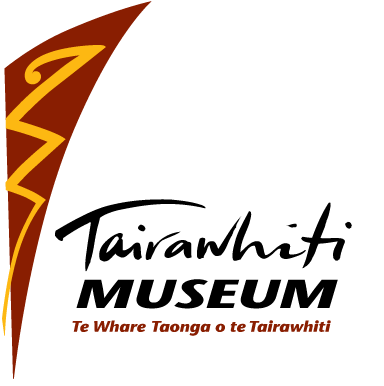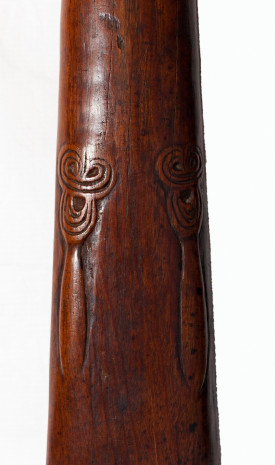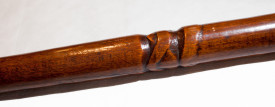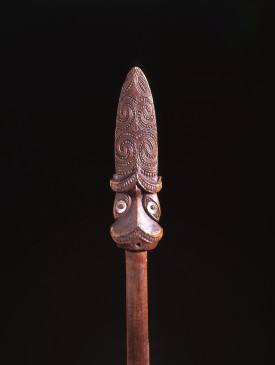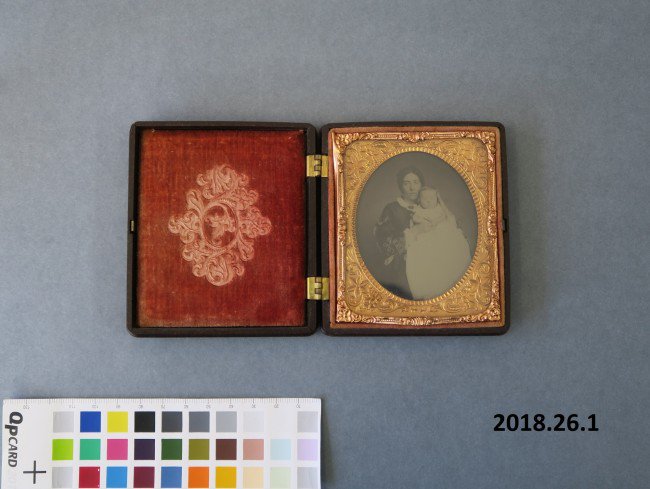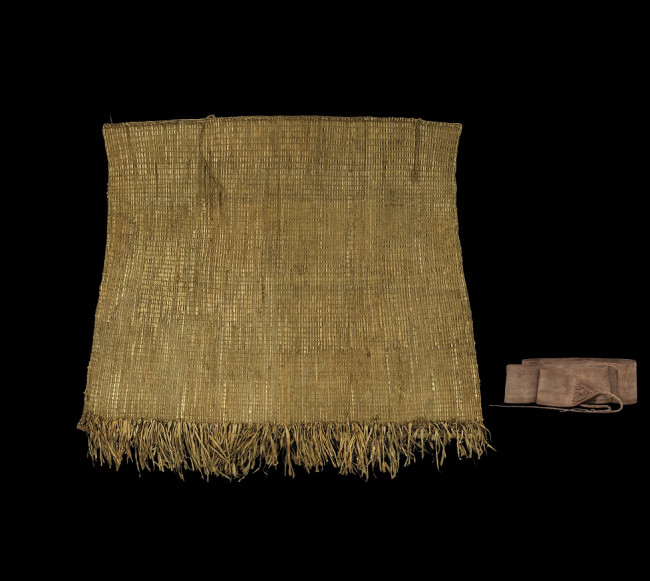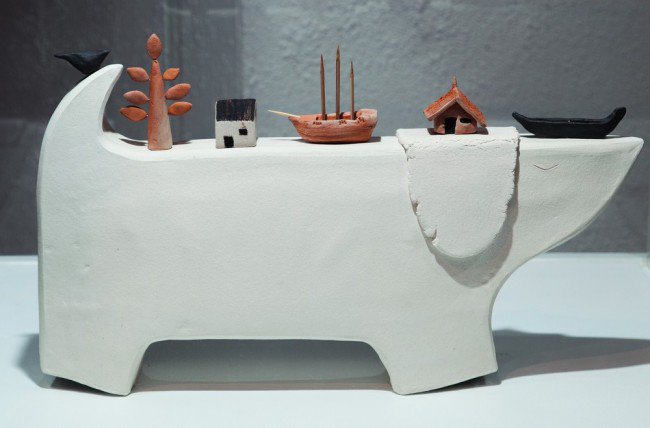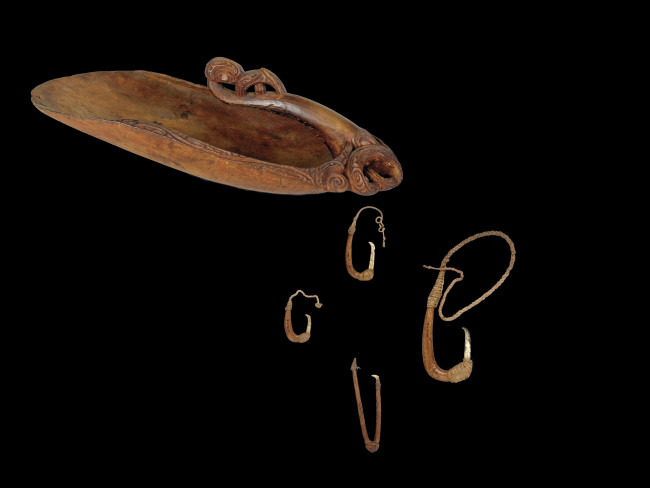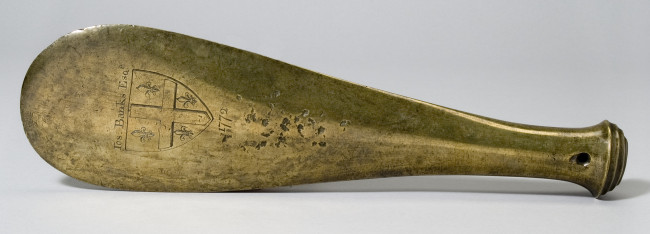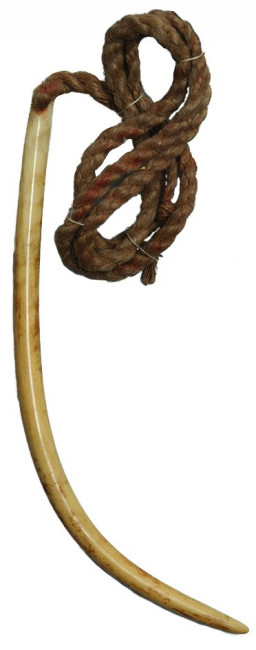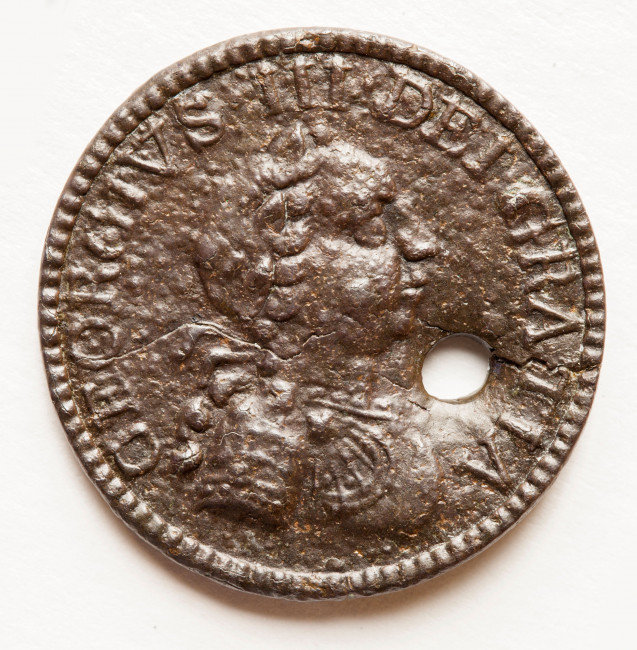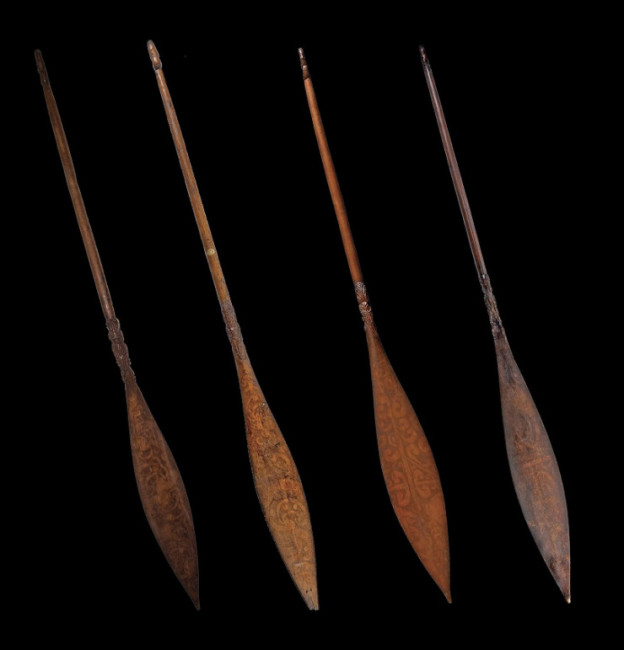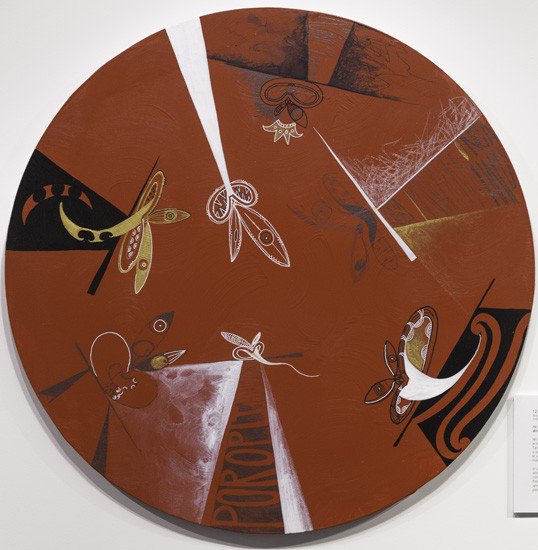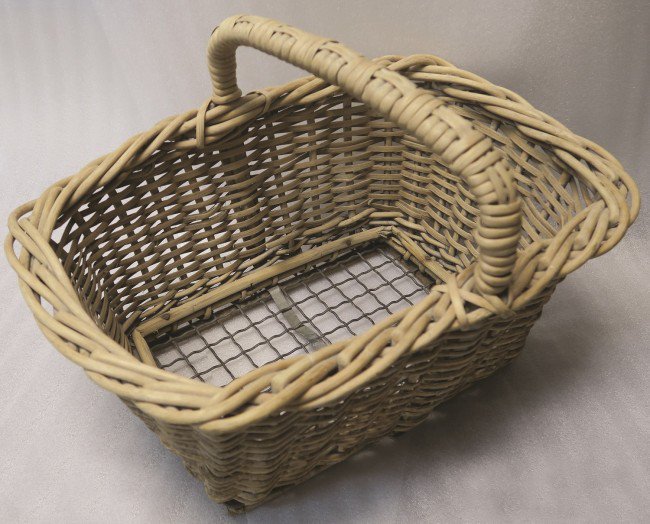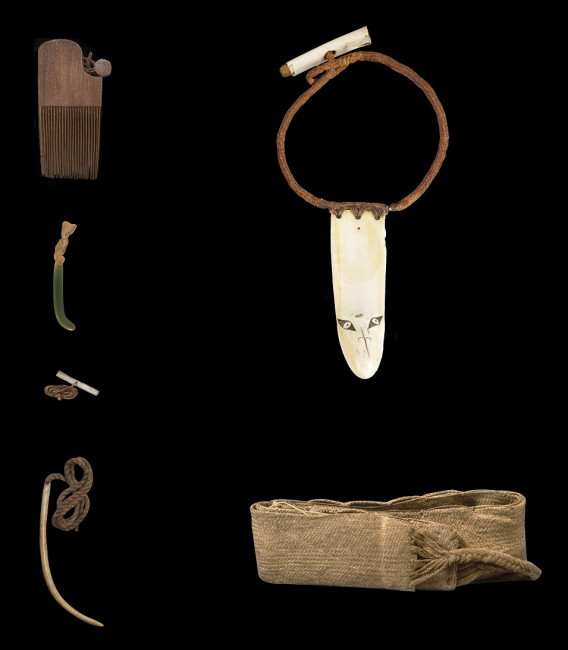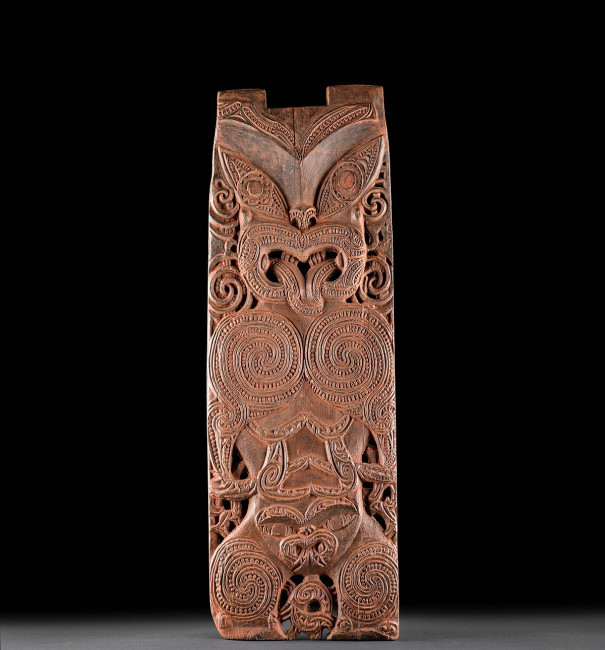Tīmata ki te taha mauī
Pouwhenua weapon
Rākau Wood
Ko te pouwhenua te rākau taketake o ngā rākau riri a te Māori. He hanganga i ahu mai i te whiunga o Tūhapairangi e te atua o te riri, e Tūmatauenga, i okaina tōna kōpako ki te koikoi, ā, koina oti tōna hanga. I rerekē ai i te taiaha, he kurupā tōna, he tīngongi tōna. Ko te tīngongi hei puringa tāmau. He wahanga whakairo anō me kore ake te tīngongi, he hangarite ēnei tohu whakairo kei ngā taha areare. Heoti ko ōna kawenga me kore ake te taiaha.
The pouwhenua is the most ancient of all the two handed weapons. The war-god Tūmatauenga killed Tūhapairangi by stabbing his spear through the back of Tūhapairangi’s head so that its point protruded though Tūhapairangi’s mouth. This is said to be the origin of its distinctive shape. The sharp point is known as the kurupā, and the carved band which provides a good grip is the tīngongi. This pouwhenua has an additional symmetrical carving design near the ate (side blades) which could also function as a grip. Fundamentally, the pouwhenua has the same functions as the taiaha.
On loan from Cambridge Museum of Archaeology and Anthropology, D1914.62
Tewhatewha weapon
Rākau Wood
Hai te ringa kotahi, he rākau tūtohi nā te ngārahu. Hai ngā ringa e rua, he rākau o te riri. I rerekē ai tēnei rākau i tōna kurupā, i tōna upoko-hou. Hei te takiwā o te upoko-hou whakamaua ai he pohoi, e pai ai te kitea mai ngā tūtohinga e te ngohi. Hei tōna rapa he tīngongi, hei puringa tāmau, ā, ko te pito kokoi ko te ate. Nā rā, ko te kurupā kē hei tā, hei karo anō, ko ngā ripa tauārai hei whāngai whakarehu.
As a single handed weapon, this was the chief’s signaling staff; as a double handed weapon it was his quarter staff. Its unique characteristics include an axe-head shape at one end, usually adorned with an array of feathers (pohoi). Along the body (rapa) is a carved gripping piece (tīngongi), and the pointed portion is known as the ate. The flat side (kurupā) of the axe-head is used for striking and also for deflecting, while both ends were used for thrusting.
On loan from Cambridge Museum of Archaeology and Anthropology, D1914.64
Taiaha weapon
Rākau, anga pāua Wood, pāua shell
Ko te taiaha te rākau riri rongonui a te Māori, i hāpaihia ai hei tā wawe, hei wero pū rānei, me kore hoki ngā toroparawae. Ko ōna tohu he upoko me te ārero kua whakairohia, ā, ko ngā mata ā rūrū he mea puru ki te pāua. Tēnā ko ēnei, kāore anō i oti, ko ngā whatu mau pāua e rua he taratara ā waho. He 1.85 mita te tāroatanga o tēnei taiaha.
Taiaha are one of the more common double-handed staffs. They are used for quick, sharp strikes or stabbing thrusts which require agile toroparawae (footwork). Common features include a carved upoko (head) and protruding arero (tongue) with two sets of eyes inlaid with pāua. This taiaha is unusual because it only has one pair of eyes and the pāua inlay has been notched around the outer edge. This taiaha is 1.85 metres long.
On loan from Cambridge Museum of Archaeology and Anthropology, D1914.61
Ambrotype, possibly of Lucy and her daughter Ida Tiffen
The museum is offered many interesting items for the collection over the course of the year. Often they are seemingly ordinary, everyday objects, but what makes each of them special and worthy of collecting is the wonderful stories they can tell us about our region’s history. This wicker basket is certainly one such object. This basket was used by William Hamilton (known as Ham) Hannah (b. 1920, d.1967) to deliver bread for Walter Findlay’s Bakery in the 1930s. Ham would have delivered bread around Gisborne by horse and cart. A few people out there may remember having bread delivered by him, perhaps using this basket! Ham served as a Driver in the Army Service Corps in the Second World War and continued to work as a driver when he returned to Gisborne after the war. In the 1960s, he was the Custodian at Churchill Park. He was married to Sarah (Sadie) and they had four children. We would like to thank Julie Hannah for gifting her father-in-law’s breadbasket to the museum.
Ham and two of his four children, Kevin (left) and Gareth (right), posing in the basket in the garden of the family’s home.
Walter Findlay’s advert, The Gisborne Herald, 20 October 1941
Tū te Whaihanga Showcase 9
Tātua belt Kahu kurī dog-skin cloak
Weight on the back of Te Kuri a Paoa by Peggy Ericson
The museum is offered many interesting items for the collection over the course of the year. Often they are seemingly ordinary, everyday objects, but what makes each of them special and worthy of collecting is the wonderful stories they can tell us about our region’s history. This wicker basket is certainly one such object. This basket was used by William Hamilton (known as Ham) Hannah (b. 1920, d.1967) to deliver bread for Walter Findlay’s Bakery in the 1930s. Ham would have delivered bread around Gisborne by horse and cart. A few people out there may remember having bread delivered by him, perhaps using this basket! Ham served as a Driver in the Army Service Corps in the Second World War and continued to work as a driver when he returned to Gisborne after the war. In the 1960s, he was the Custodian at Churchill Park. He was married to Sarah (Sadie) and they had four children. We would like to thank Julie Hannah for gifting her father-in-law’s breadbasket to the museum.
Ham and two of his four children, Kevin (left) and Gareth (right), posing in the basket in the garden of the family’s home.
Walter Findlay’s advert, The Gisborne Herald, 20 October 1941
Tū te Whaihanga Showcase 3
Tīheru/Tata bailer Matau fishhook
Tū te Whaihanga Showcase 13
Patu Parāhe Brass patu
Aurei
Aurei cloak pin Rei-puta, muka harakeke Whalebone-tooth, flax fibre
Tū te Whaihanga Showcase 8
Mētara Koroneihana a Hōri III George III Coronation medalet
Tū te Whaihanga Showcase 5 and 7
Hoe paddles
Hamuera by Erena Koopu
Hamuera by Erena Koopu, 2018 Acrylic and graphite on canvas, 710mm diameter This work by Erena Koopu was part of the exhibition Hei ō Mō Apanui | Iwi Sustenance held at Tairāwhiti Museum in 2018 and purchased by the Friends of Tairāwhiti Museum for the collection. He waiata a ringa (an action song) Performed by Te Kapa Haka o Te Whānau a Apanui at Te Matatini in the year 2005 in Palmerston North. Nō te tau 2004 ka whakaturehia e te kāwanatanga te pire takutai moana, e riro ai te taitara o te papa moana, tōna ritenga, he muru whenua. I taua tau rā, ko Tāriana Tūria te wahine toa o Reipa kāore i tautokona taua pire, ā, ko ētahi atu o ana hoa mema Māori, i tautoko tonu. He waiata-ā-ringa tēnei e kōrero ana ki aua mema rā, kia aro ki ngā tohutohu a ngā poropiti Māori, kei reira te māramatanga e noho ana. In 2004 the Government passed the controversial Foreshore and Seabed Bill, which transferred title to the crown, and in itself is a form of modern day confiscation. In that same year, Tāriana Tūria, Māori MP of Labour crossed the floor, while the rest of her Māori colleagues remained seated. This action song speaks to those seated members, and urges them to remember the lessons of past Māori prophets, as clarity must resides in their messages.
Ham Hannah’s Breadbasket
The museum is offered many interesting items for the collection over the course of the year. Often they are seemingly ordinary, everyday objects, but what makes each of them special and worthy of collecting is the wonderful stories they can tell us about our region’s history. This wicker basket is certainly one such object. This basket was used by William Hamilton (known as Ham) Hannah (b. 1920, d.1967) to deliver bread for Walter Findlay’s Bakery in the 1930s. Ham would have delivered bread around Gisborne by horse and cart. A few people out there may remember having bread delivered by him, perhaps using this basket! Ham served as a Driver in the Army Service Corps in the Second World War and continued to work as a driver when he returned to Gisborne after the war. In the 1960s, he was the Custodian at Churchill Park. He was married to Sarah (Sadie) and they had four children. We would like to thank Julie Hannah for gifting her father-in-law’s breadbasket to the museum.
Ham and two of his four children, Kevin (left) and Gareth (right), posing in the basket in the garden of the family’s home.
Walter Findlay’s advert, The Gisborne Herald, 20 October 1941
Tū te Whaihanga Showcase 10
Tātua belt Heru Comb Rei-puta whale-tooth necklace Aurei cloak pin Poro-toroa Albatross toggle Kapeu ear pendant
Tū te Whaihanga Showcase 12
Te Pou o Hinematioro
The museum’s collections are always growing and on this page we share some of the highlights. Our thanks to the donors for their support.
Donating to the collection
Visit our Donations page for more information.
Research and access
Researchers can view collections that are not on display by making an appointment with the Museum Collection Manager. Staff can also take small group tours through the collection storage facilities by appointment. Please note that staff are not always available immediately and it is advisable to make arrangements as far in advance as possible, particularly if you are only visiting Gisborne for a short period.
Researchers who are unable to visit in person can make their enquiry by email, letter or telephone
